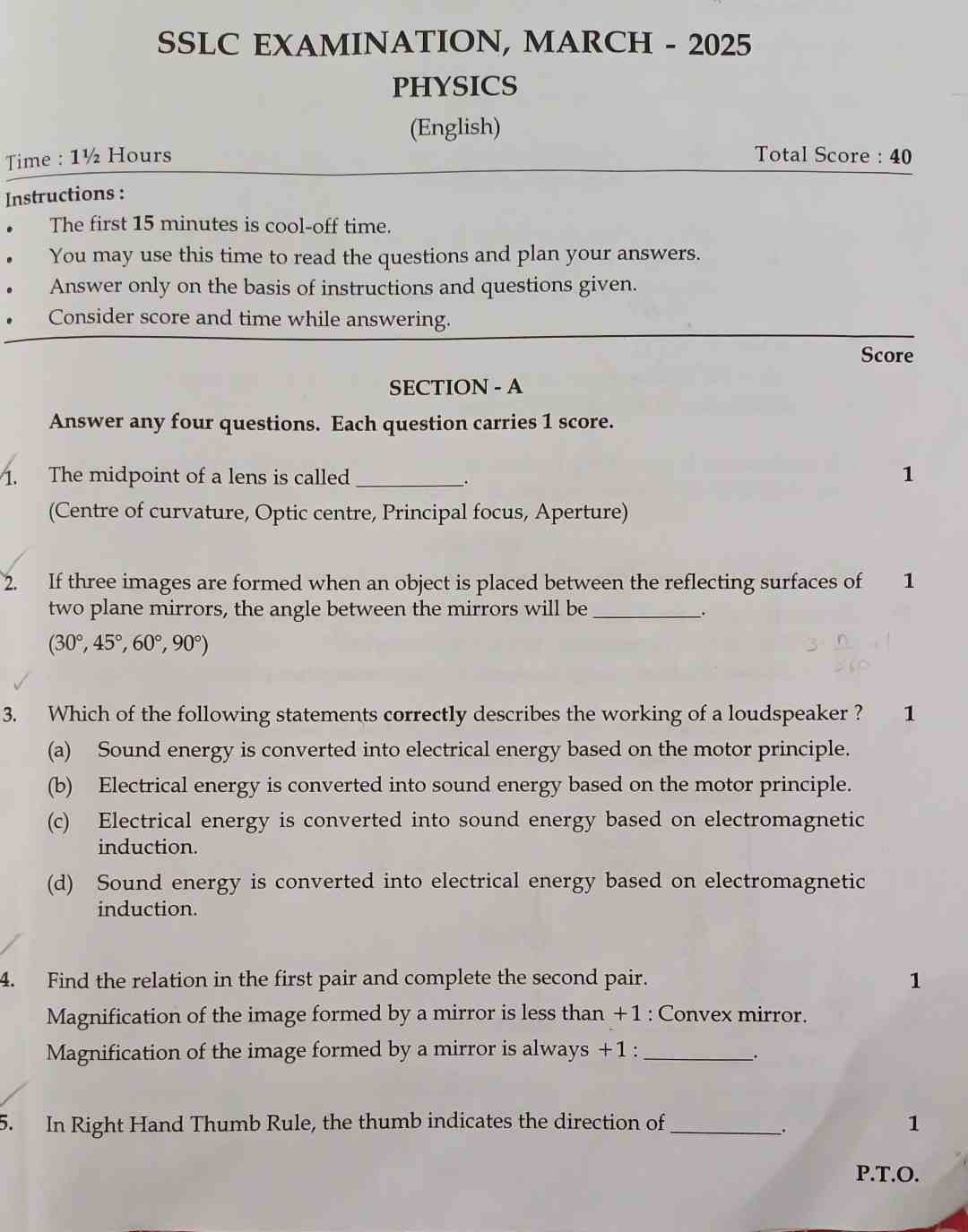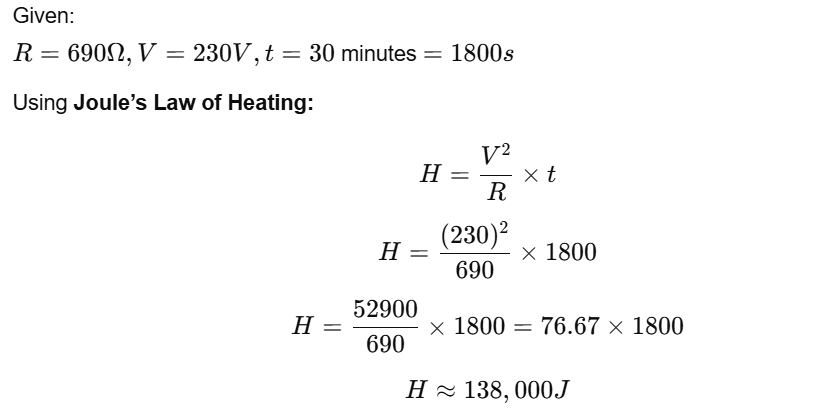Kerala SSLC Physics Question Paper 2025 and Answer Key: The Kerala SSLC Physics (Secondary School Leaving Certificate) Exam 2025 is a crucial milestone for Class 10 students in Kerala. The exam is over now. Among the various subjects, Physics is considered one of the most important due to its conceptual depth and scoring potential. The exam is being conducted from 9:30 AM to 11:15 AM, with an additional 15 minutes allotted for reading the question paper. In this article, we will provide the Kerala SSLC Physics Question Paper 2025 PDF along with the answer key by experts, helping students analyze their performance and estimate their scores.
Check: Kerala SSLC Physics Exam Analysis 2025
Kerala SSLC Physics Question Paper 2025: Paper Pattern Overview
The Kerala SSLC Physics Question Paper 2025 comprised a total of 20 questions carrying 40 marks in total. The exam duration was 1.5 hours, with an additional 15 minutes allotted for reading the question paper.
The question paper was structured into four sections as follows:
- Section A – 1-mark questions
- Section B – 2-mark questions
- Section C – 3-mark questions
- Section D – 4-mark questions
Kerala SSLC Physics Question Paper 2025: Download PDF

Kerala SSLC Physics Question Paper 2025: Download PDF
Kerala SSLC Physics Answer Key 2025: Download PDF
We will provide the expert-verified Kerala SSLC Physics Answer Key 2025 here after the exam. The answer key will help students:
- Verify their answers and estimate their probable scores.
- Identify mistakes and understand correct solutions.
- Assess their overall performance and predict expected results.
Kerala SSLC Physics Answer Key 2025
SECTION - A
(Each question carries 1 mark)
1.The midpoint of a lens is called
Answer: Optic centre
2.If three images are formed when an object is placed between the reflecting surfaces of two plane mirrors, the angle between the mirrors will be
Answer: 60°
(Formula: θ = 360° / (n - 1), where n = 3 → θ = 360° / 2 = 60°)
3.Which of the following statements correctly describes the working of a loudspeaker?
Answer: (b) Electrical energy is converted into sound energy based on the motor principle.
4.Find the relation in the first pair and complete the second pair.
Answer:
- Magnification of the image formed by a mirror is less than +1 → Convex mirror
- Magnification of the image formed by a mirror is always +1 → Plane mirror
5.In Right Hand Thumb Rule, the thumb indicates the direction of
Answer: Current
The Kerala SSLC Physics Exam 2025 plays a significant role in shaping a student's academic future. With the question paper format, answer key, and exam analysis, students can evaluate their performance and prepare better for future exams. Stay tuned for more such useful resources for the upcoming exams.
SECTION - B
(Each question carries 2 marks. Answer any four.)
6.Nowadays, discharge lamps are replaced by LED lamps for domestic lighting.
(a) How is electrical energy converted into light energy in discharge lamps?
Answer: Electrical energy excites gas atoms inside the discharge lamp, producing ultraviolet (UV) radiation, which is then converted into visible light by a phosphor coating.
(b) What are the advantages of LED lamps over discharge lamps?
Answer: Advantages of LED lamps over discharge lamps are as follows:
- Higher energy efficiency
- Longer lifespan
- Lower heat emission
- No harmful gases like mercury
7.What is transmission loss in an electrical power distribution system? What measures have been taken to minimize it?
Answer: Transmission loss refers to energy loss as heat due to the resistance of electrical wires.
Measures to minimize it:
- Using high-voltage transmission to reduce current and power loss
- Using superconducting materials with low resistance
- Efficient transformers for voltage regulation
8.(a) A ray of light entering from water to air at an angle of incidence 52° does not undergo refraction. Why?
Answer: This occurs because the angle of incidence is greater than the critical angle of water (which is approximately 48.75°). As a result, total internal reflection takes place instead of refraction.
(b) Write a method that makes refraction possible here.
Answer: Decrease the angle of incidence to a value less than the critical angle so that light can pass through the surface instead of being totally internally reflected.
9.Power of lens is -0.5 D.
(a) What is the relation between the power of a lens and its focal length?
Answer: The power P of a lens is given by:
P=100/f
where f is the focal length in centimeters.
(b) Calculate the focal length of this lens.
Answer:
Given: P=−0.5D
Using the formula:
f=100/P=100/0.5=−200 cm=−2 m
The negative sign indicates a concave lens.
10.The government is promoting the installation of solar panels by giving incentives to boost electricity generation. Explain its significance in the context of the energy crisis.
Answer: Importance of solar energy in the context of the energy crisis:
- Solar energy is a renewable and sustainable source of power.
- Reduces dependency on fossil fuels, minimizing carbon emissions.
- Provides electricity in remote areas without grid access.
- Reduces energy costs in the long term.
Q11. (a) What are the characteristics of a good heating coil?
- High resistance
- High melting point (e.g., nichrome)
- High oxidation resistance
(b) Calculate the heat energy produced by this heater when it works for 30 minutes.

Heat energy produced = 138 kJ
Q12. a) Why does the bulb glow when AC flows through the coil?
- Due to mutual induction, the alternating current in one coil induces a current in the secondary coil, causing the bulb to glow.
(b) What happens when a soft iron core is placed inside the inductor?
- The intensity of brightness increases because the iron core enhances the magnetic field, increasing the induced current.
Q13. (a) Mark the direction of current flow in the solenoid.
Using Right-Hand Rule, if fingers curl in the direction of current, the thumb points to the north pole.
(b) Identify and mark the north pole.
The end where the current flows counterclockwise is the north pole.
Q14. (a) Which diagram shows hypermetropia (long-sightedness)?
Figure 2 (where the image forms behind the retina).
(b) How is this defect corrected?
Using convex lenses to converge light rays onto the retina.
Q15. (a) Drawbacks of partial combustion?
Produces harmful gases (CO, soot)
Less energy efficiency
(b) Conditions for complete combustion?
Sufficient oxygen supply
High temperature
More answers are being updated..............
Also Check:
Kerala SSLC Maths Exam 2025: Check Question Paper & Answer Key
Comments
All Comments (0)
Join the conversation